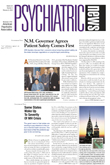Long-term research that has followed children into adolescence and early adulthood is beginning to yield developmental pathways that may allow early recognition of children at risk for depression and mood disorders.
Two studies appearing in the December 2003 American Journal of Psychiatry highlight the importance of internalizing behaviors in early childhood, as well as familial characteristics and other factors, in the later development of depression and anxiety.
One report looked at childhood and adolescent predictors—up to age 15—of major depression in the age range of 18 to 26, a period defined by the researchers as the “transition to adulthood.”
They followed 354 participants in a single-age cohort. Data were collected from multiple informants, including mothers and participants, at seven major time points: ages 5, 6, 9, 15, 18, 21, and 26.
During the ages 18 to 26, 82 participants (23.2 percent) experienced major depression. Statistical analysis relating data collected during the period up to age 15 to major depression in the later stage showed family violence, family composition, internalizing problems during adolescence, and low family cohesion to be the most important contributing factors.
Internalizing problems were reported by having the children complete the 20-item Youth Report and having mothers fill out the Child Behavior Checklist. These problems include withdrawn behavior, somatic complaints, and depression and anxiety.
As early as age 9, the respondents who later experienced depression rated themselves more anxious and depressed than their peers. At age 15, both teens and mothers reported those in the depression group as having more internalizing behavior problems.
“The most important finding is that there are quite robust indicators in mid-childhood indicative of later major depression,” study author Helen Z. Reinherz, Sc.D., told Psychiatric News. “By the time a child reaches adolescence, there are strong indications in the family and in the child’s view of the family that can be very helpful in identifying these children.”
She is a professor and principal investigator in the Simmons Longitudinal Study at Simmons College in Boston.
She added that the fact that children and teens can express themselves in a self-report format also bodes well for early identification and treatment.
“These ways of perceiving themselves and their families can enlighten caretakers and physicians about the child’s mental health status,” she said. “A teen can assess his or her own sadness and anxiety.”
In a second report, Dutch researchers looked at parent reports of behavioral and emotional problems obtained using the Child Behavior Checklist for children and adolescents aged 4 to 16 from the Dutch general population. At follow-up 14 years later, lifetime mood and anxiety diagnoses were obtained from 1,580 subjects using a standardized DSM-IV interview.
Statistical models were used to predict incidence of mood and anxiety disorders from childhood problems and demographic variables.
Study results showed that mood disorders were significantly predicted by high scores on the anxious/depressed scale and internalizing (withdrawn, somatic complaints, and anxious/depressed) scores. Anxiety disorders were significantly predicted by the social problems scale and the “externalizing composite,” which includes delinquent and aggressive behavior. Anxiety disorders predominantly started in childhood and early adolescence, while the incidence of mood disorders increased sharply in adolescence and young adulthood.
APA Trustee-at-Large and child psychiatrist David Fassler, M.D., who reviewed the reports, said they both “give us helpful information on how childhood behaviors can predict risk for adult psychiatric disorders.”
He added, “So often we see kids at a particular point in their life, and what we are seeing is a cross-section. This research helps us to develop a more long-term perspective. If kids are at risk, I want them and their parents to recognize the signs as early as they can.”
Am J Psychiatry 2003 160 2141
Am J Psychiatry 2003 160 2116
